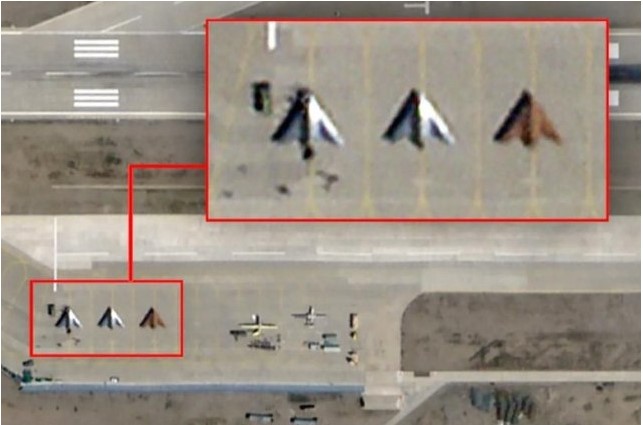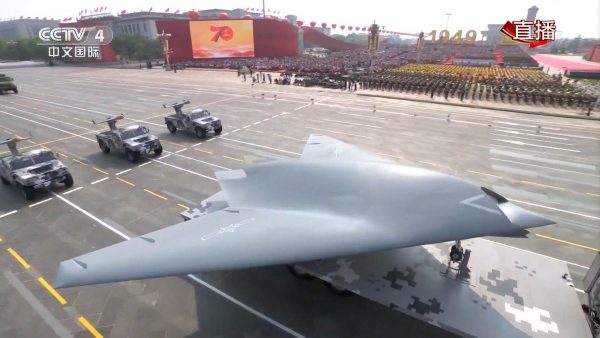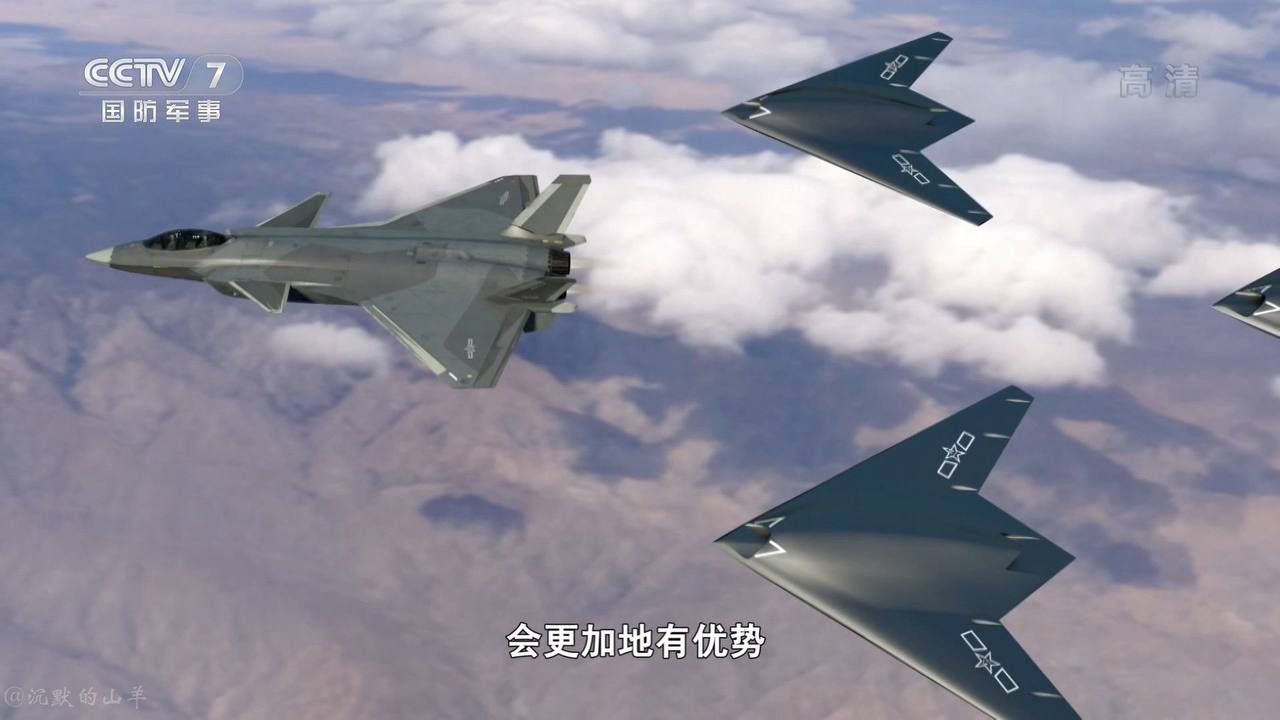In a new headache for India, China has boosted its air power near the contested Line of Actual Control (LAC). Following the deployment of fifth-generation J-20 fighter jets, Beijing has now reportedly deployed its stealthy flying-wing uncrewed combat air vehicles (UCAV), the GJ-11 Sharp Sword, near the border with India’s Sikkim.
Worryingly, the stealthy GJ-11 Sharp Sword could partner the J-20 in a Manned-Unmanned Teaming (MUMT) format.
Furthermore, the stealthy drone could penetrate contested airspace and perform a variety of missions, including Intelligence, Surveillance, and Reconnaissance (ISR), Electronic Warfare (EW), jamming enemy air command and control centres, and air-to-surface and air-to-air strikes.
According to satellite imagery from the open-source intelligence platform Planet Labs, three GJ-11 Sharp Sword flying-wing UCAVs were deployed at the Shigatse Air Base in China’s Tibet Autonomous Region between August 6 and September 5.
Notably, the Shigatse Air Base in Tibet is situated just around 90 miles northeast of the boundary with India’s Sikkim state.
The sensitive area has seen multiple armed clashes over the years.

In September 1967, India and China fought one of their bloodiest armed confrontation at Nathu La pass in Sikkim, in which 65 Indian soldiers were killed. On the Chinese side, 300 to 400 soldiers were killed, according to Indian sources; however, independent sources placed the figure of PLA soldiers killed at around 200 to 300.
Just one month later, in October 1967, clashes erupted again at the nearby Cho La Pass, in which nearly 40 Chinese soldiers were killed. India prevailed in both these confrontations, boosting the morale of the Indian military following the setback in the 1962 Sino-India war.
A tenuous peace prevailed for nearly four decades before tensions erupted again in 2017. A two-month-long military standoff followed in the Dokhlam plateau, near the tri-junction area where the borders of India, China, and Bhutan converge.
Again, minor clashes in the Sikkim sector were reported following the Galwan clash in June 2020.
For India, the area is crucial, as it overlooks the strategic ‘Silliguri Corridor,’ also known as the Chicken’s Neck, a narrow strip of land connecting mainland India with its Northeastern states.
The deployment of China’s most advanced stealth fighter jets and drones near the Sikkim border is a worrisome signal for India, suggesting that, despite the recent thaw in India-China relations, New Delhi cannot let its guard down on the nearly 3,488-km-long LAC.
The GJ-11 Sharp Sword UCAV
The GJ-11 Sharp Sword UCAV has been in development for over a decade. A substantially non-stealthy version of the drone flew in 2013.
The stealthy version of the GJ-11 was first officially revealed in an October 2019 military parade marking the 70th anniversary of the People’s Republic of China (PRC) (or the National Day) and has been widely believed to rival the US stealth RQ-170 Sentinel drone.
Developed and manufactured by AVIC, the first photos were only top and side views of the drone, which was mounted on a truck during the parade.

Subsequent photos of a scale model in September 2021, taken during an air show in China, revealed its two internal belly weapons bays open between the side landing gears.
“Each bay has four ammunition, which look like guided precision air-to-ground glide bombs. Experts said that the drone would likely carry multiple types of precision ammunition, including larger ones that were not displayed at the air show,” a Global Times report had then pointed out.
It further quoted military aviation expert Zhang Xuefeng, who said the flying-wing-shaped drone had high stealth and subsonic cruise capability, coupled with extended range. Narrators on CCTV during the parade said that the GJ-11’s primary mission would be to conduct deep-penetrating strikes against critical targets.
The “GJ” in the designation, which also means ‘gonji’ (Chinese for ‘attack’), is another indication that the UCAV’s primary role is strike-oriented.
The stealthy UCAV was also displayed during the September 3 military parade in Beijing this year.
Notably, the GJ-11 UCAV is also optimized for carrier-capable operations.
Chinese military aviation expert Andreas Rupprecht posted a picture in December 2023 that showed a land-based mock aircraft carrier facility in Wuhan. That facility had dummies of the J-15, J-35/J-31/FC-31 Gyrfalcon, KJ-600, and a GJ-11 on the flight deck.
Via ACuriousPLAFan/SDF: 😮
Supposedly not a recent image, but still the carrier mock-up and test facility at Wuhan has gained some new aircraft: Visible now are clearly mock-ups of J-15, J-35, KJ-600 and a GJ-11H on the flight deck.
(Image via @伏尔戈星图 from Weibo) pic.twitter.com/UL6uk81zh4
— @Rupprecht_A (@RupprechtDeino) December 19, 2023
Another People’s Liberation Army (PLA) expert, Rick Joe, called it a “near confirmation” that a “flying wing UAV/UCAV is intended for carrier aviation.”
Another possible role would be flying alongside the J-20 stealth fighter as a part of a manned-unmanned team. Screen grabs from an October 2022 digital representation on China Central Television (CCTV) showed J-20s and H-6K strategic bombers controlling wingman drones, and the drones in the video were GJ-11s.

The deployment of these drones at the Shigatse Air Base in Tibet suggests that the stealthy UCAV is nearing operationalization.
The GJ-11’s Stealthy Features
The GJ-11 UCAV has a flying-wing design optimized for stealth.
A flying-wing UAV (Unmanned Aerial Vehicle) is a type of drone with a tailless, fixed-wing configuration, where the aircraft’s body generates lift, resembling a single large wing without a distinct fuselage or traditional tail section.
This concept draws on aerodynamic principles pioneered in manned aircraft, such as the Northrop B-2 Spirit bomber, and adapts them for unmanned systems.
Furthermore, the UCAV features an internal weapons bay. The lack of a tail, protruding parts, and smooth contours ensures a low Radar Cross-Section (RCS).
Additionally, the UCAV features a flat exhaust nozzle, which is typically used to reduce its infrared signature.
According to reports, the UCAV has an RCS of less than 0.05 square meters.
China’s Rising Air Power At The Shigatse Air Base
The Shigatse Air Base in Tibet is situated just around 90 miles from India’s Sikkim.
The air base features one of the world’s longest airstrips, stretching approximately 16,404 feet (5,000 meters).
In 2017, as India and China clashed on the nearby Doklam plateau, China constructed an additional 9,840-foot (3,000-meter) auxiliary runway with seven large aircraft parking spots.
China has also deployed its stealth J-20 fighter jets on the airbase. In a satellite image from May last year, six J-20 fighter jets were spotted on the Shigatse Air Base.
Analysis of imagery collected over Shigatse Air Base in China shows the deployment of six likely J-20 stealth fighter aircraft near the Indian border. https://t.co/epfzHD3Daa#GEOINT #China #Shigatse #J20 pic.twitter.com/hyijF3T1ao
— AllSource Analysis (@AllSourceA) May 29, 2024
According to media reports, China is also constructing an expanded apron and at least five hangars at the air base.
Apart from the fifth-generation J-20, satellite imagery from the air base has also confirmed the presence of J-10Cs, airborne early warning and control aircraft, helicopters, and stealthy drones.
Shigatse was also reportedly the first air base to operate the high-flying WZ-7 Soaring Dragon reconnaissance drone.
China’s infrastructure and air power buildup at the Shigatse air base is a clear warning signal for India, given the history of violent clashes between the two countries in the Sikkim sector.
However, India is not sitting idle either. The Indian Air Force’s base in Hasimara, West Bengal, hosts the IAF’s second squadron of 16 Rafale fighter aircraft. These Rafales are tasked with defending the Himalayan frontier over Eastern India.
Besides, India has also deployed the Su-30 MKI near the LAC.
According to reports earlier this year, India has also deployed one squadron of the S-400 air defense system near the LAC in the Sikkim sector.
China’s deployment of advanced stealth drones at the Shigatse air base could be a response to India’s deployment of S-400 near the border.
- Sumit Ahlawat has over a decade of experience in news media. He has worked with Press Trust of India, Times Now, Zee News, Economic Times, and Microsoft News. He holds a Master’s Degree in International Media and Modern History from the University of Sheffield, UK.
- VIEWS PERSONAL OF THE AUTHOR.
- He can be reached at ahlawat.sumit85 (at) gmail.com




